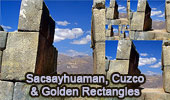Sacsayhuaman, Cuzco
Sacsayhuaman (also known as Saksaq Waman) is an Inca walled complex near the old city of Cusco, at an altitude of 3,701 m.
Some believe the walls were a form of fortification, while others believe it was only used to form the head of the Puma that Sacsayhuaman along with Cuzco form when seen from above. Like much Inca stonework, there is still mystery surrounding how they were constructed. The structure is built in such a way that a single piece of paper will not fit between many of the stones. This precision, combined with the rounded corners of the limestone blocks, the variety of their interlocking shapes, and the way the walls lean inward, is thought to have helped the ruins survive devastating earthquakes in Cuzco. The longest of three walls is about 400 meters. They are about 6 meters tall. Estimated volume of stone is over 6,000 cubic meters. Estimates for the largest limestone block vary from 128
tones to almost 200 tones. Source
Wikipedia:
Sacsayhuaman.
Cusco Cathedral is a Baroque-style cathedral built on the foundations of the palace of the Inca Wirachocha in Cusco.
Construction began in 1550, using many stones looted from the site of the hillside Sacsayhuaman
fortress.

|